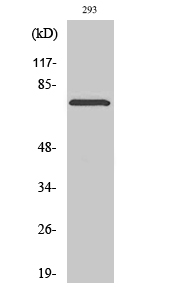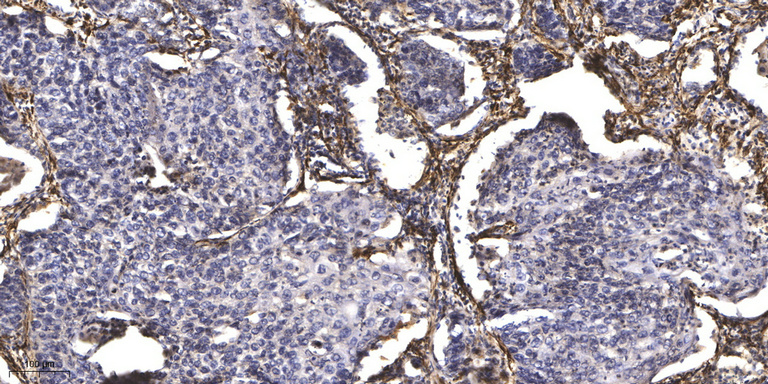LIMK-2 (phospho Thr505) Polyclonal Antibody
- Catalog No.:YP0162
- Applications:WB;IHC;IF;ELISA
- Reactivity:Human;Mouse;Rat
- Target:
- LIMK-2
- Fields:
- >>Axon guidance;>>Fc gamma R-mediated phagocytosis;>>Regulation of actin cytoskeleton;>>Human immunodeficiency virus 1 infection
- Gene Name:
- LIMK2
- Protein Name:
- LIM domain kinase 2
- Human Gene Id:
- 3985
- Human Swiss Prot No:
- P53671
- Mouse Gene Id:
- 16886
- Mouse Swiss Prot No:
- O54785
- Rat Gene Id:
- 29524
- Rat Swiss Prot No:
- P53670
- Immunogen:
- Synthesized phospho-peptide around the phosphorylation site of human LIMK-2 (phospho Thr505)
- Specificity:
- Phospho-LIMK-2 (T505) Polyclonal Antibody detects endogenous levels of LIMK-2 protein only when phosphorylated at T505.
- Formulation:
- Liquid in PBS containing 50% glycerol, 0.5% BSA and 0.02% sodium azide.
- Source:
- Polyclonal, Rabbit,IgG
- Dilution:
- WB 1:500 - 1:2000. IHC 1:100 - 1:300. IF 1:200 - 1:1000. ELISA: 1:10000. Not yet tested in other applications.
- Purification:
- The antibody was affinity-purified from rabbit antiserum by affinity-chromatography using epitope-specific immunogen.
- Concentration:
- 1 mg/ml
- Storage Stability:
- -15°C to -25°C/1 year(Do not lower than -25°C)
- Other Name:
- LIMK2;LIM domain kinase 2;LIMK-2
- Molecular Weight(Da):
- 72kD
- Background:
- There are approximately 40 known eukaryotic LIM proteins, so named for the LIM domains they contain. LIM domains are highly conserved cysteine-rich structures containing 2 zinc fingers. Although zinc fingers usually function by binding to DNA or RNA, the LIM motif probably mediates protein-protein interactions. LIM kinase-1 and LIM kinase-2 belong to a small subfamily with a unique combination of 2 N-terminal LIM motifs and a C-terminal protein kinase domain. The protein encoded by this gene is phosphorylated and activated by ROCK, a downstream effector of Rho, and the encoded protein, in turn, phosphorylates cofilin, inhibiting its actin-depolymerizing activity. It is thought that this pathway contributes to Rho-induced reorganization of the actin cytoskeleton. At least three transcript variants encoding different isoforms have been found for this gene. [provided by RefSeq, Jul 2008],
- Function:
- catalytic activity:ATP + a protein = ADP + a phosphoprotein.,function:Displays serine/threonine-specific phosphorylation of myelin basic protein and histone (MBP) in vitro.,PTM:Phosphorylated on serine and/or threonine residues by ROCK1.,similarity:Belongs to the protein kinase superfamily. TKL Ser/Thr protein kinase family.,similarity:Contains 1 PDZ (DHR) domain.,similarity:Contains 1 protein kinase domain.,similarity:Contains 2 LIM zinc-binding domains.,subcellular location:Isoform LIMK2a is distributed in the cytoplasm and the nucleus.,subcellular location:Isoform LIMK2b occurs mainly in the cytoplasm and is scarcely translocated to the nucleus.,subunit:Binds ROCK1 and LKAP. Interacts with PARD3. Interacts with NISCH.,tissue specificity:Highest expression in the placenta; moderate level in liver, lung, kidney, and pancreas. LIMK2a is found to be more abundant then LIMK2b in liver, col
- Subcellular Location:
- Cytoplasm, cytoskeleton, spindle . Cytoplasm, cytoskeleton, microtubule organizing center, centrosome .; [Isoform LIMK2a]: Cytoplasm . Nucleus .; [Isoform LIMK2b]: Cytoplasm . Cytoplasm, perinuclear region . Nucleus . Mainly present in the cytoplasm and is scarcely translocated to the nucleus. .
- Expression:
- Hepatoma,Lung,Ovary,
LIMK1/2 in the mPFC Plays a Role in Chronic Stress-Induced Depressive-Like Effects in Mice. INTERNATIONAL JOURNAL OF NEUROPSYCHOPHARMACOLOGY 2020 Dec 29 WB Mouse 1:500 Hippocampus , mPFC tissue
- June 19-2018
- WESTERN IMMUNOBLOTTING PROTOCOL
- June 19-2018
- IMMUNOHISTOCHEMISTRY-PARAFFIN PROTOCOL
- June 19-2018
- IMMUNOFLUORESCENCE PROTOCOL
- September 08-2020
- FLOW-CYTOMEYRT-PROTOCOL
- May 20-2022
- Cell-Based ELISA│解您多样本WB检测之困扰
- July 13-2018
- CELL-BASED-ELISA-PROTOCOL-FOR-ACETYL-PROTEIN
- July 13-2018
- CELL-BASED-ELISA-PROTOCOL-FOR-PHOSPHO-PROTEIN
- July 13-2018
- Antibody-FAQs
- Products Images
.jpg)
- Gao, Ting-Ting, et al. "LIMK1/2 in the mPFC plays a role in chronic stress-induced depressive-like effects in mice." International Journal of Neuropsychopharmacology 23.12 (2020): 821-836.

- Western Blot analysis of various cells using Phospho-LIMK-2 (T505) Polyclonal Antibody

- Immunohistochemical analysis of paraffin-embedded human Squamous cell carcinoma of lung. 1, Antibody was diluted at 1:200(4° overnight). 2, Tris-EDTA,pH9.0 was used for antigen retrieval. 3,Secondary antibody was diluted at 1:200(room temperature, 45min).



